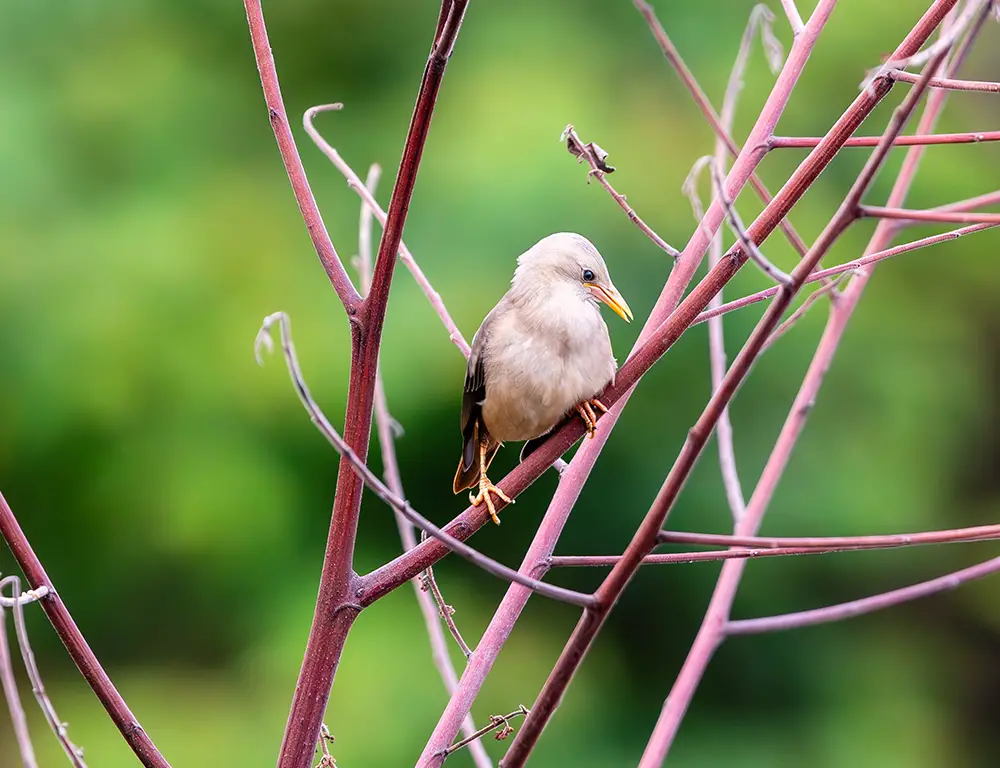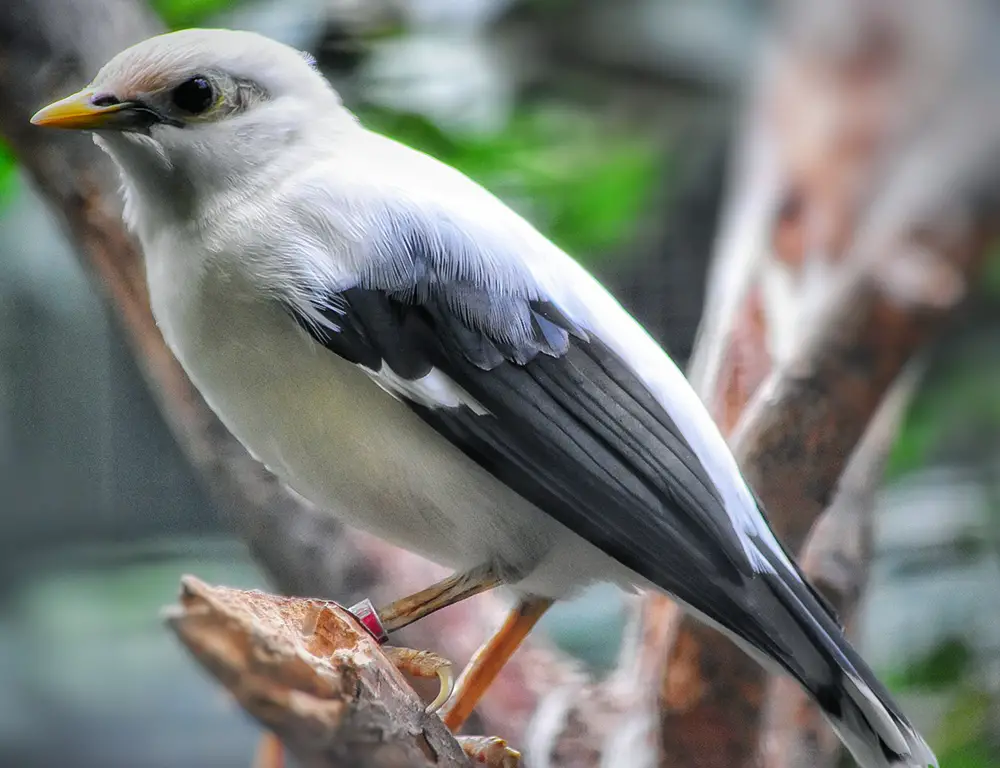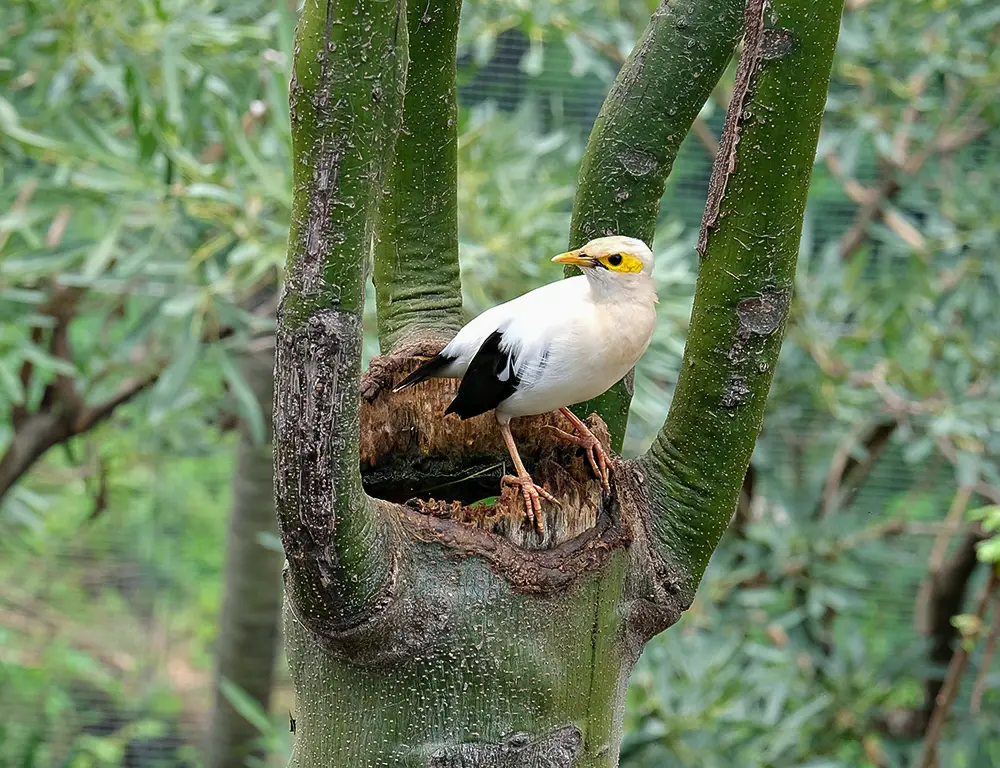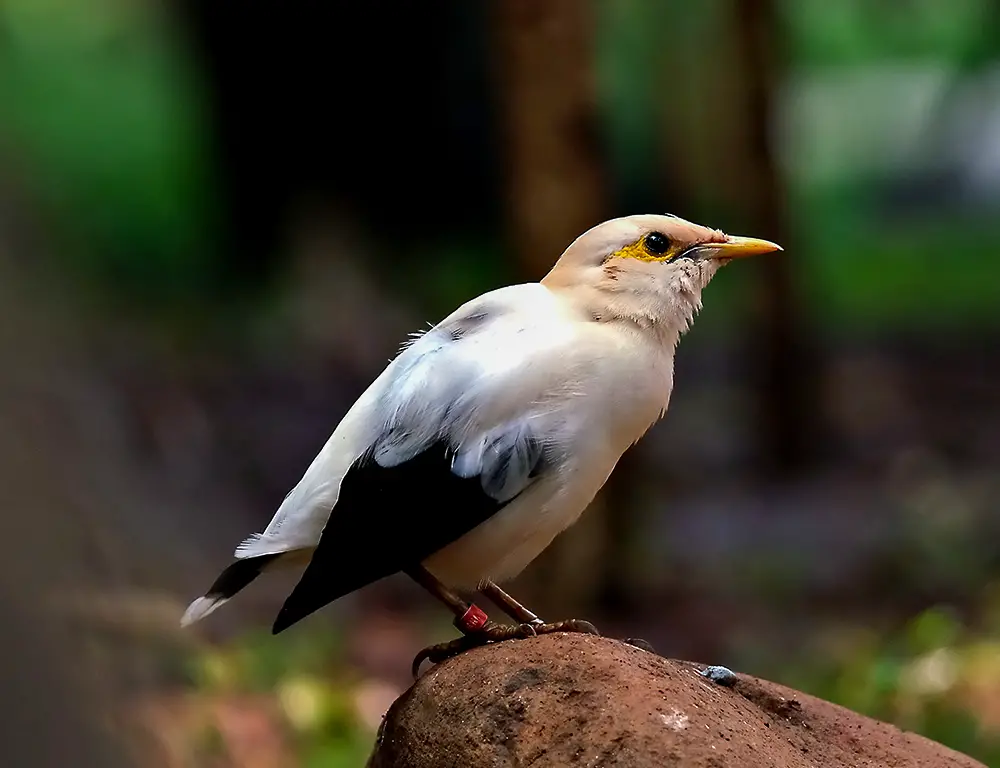In rare and exotic birds, the Black-Winged Myna, scientifically known as Acridotheres melanopterus, stands out as a captivating marvel.
Originating from the lush landscapes of Indonesia, this bird captivates with its glossy black plumage and mesmerizing blue-eyed gaze. However, a poignant narrative of struggle and survival lies beneath its striking exterior.
Threatened by illegal pet trade and habitat loss, the Black-Winged Myna faces extinction, prompting urgent conservation efforts. Yet, amidst these challenges, its social intricacies and behavioral nuances offer a glimpse into the rich tapestry of nature.
Join me as we embark on a journey to unravel the mysteries of this enigmatic species – from its native habitat to the ongoing battle for its preservation.

Habitat and Distribution of the Black-Winged Myna
The Black-Winged Myna, scientifically known as Acridotheres melanopterus, is primarily found in Indonesia, with its distribution spanning several regions within the country:
Native Range
The Black-Winged Myna is native to various islands in Indonesia, including Java, Borneo, Sumatra, and Bali. These islands provide diverse ecosystems that support the bird’s habitat needs.
Prevalent Regions
- Java: This island hosts the largest population of Black-Winged Mynas.
- Borneo: While less densely populated than Java, Borneo still harbors many of these birds.
- Sumatra and Bali: These regions have smaller populations of Black-Winged Mynas but are nonetheless crucial for the species’ overall distribution.
Habitat Preferences
- Forests: Black-Winged Mynas are commonly found in primary and secondary forests up to 800 meters above sea level. Forested areas provide these birds with essential resources such as food and nesting sites.
- Human-Dominated Landscapes: Surprisingly, Black-Winged Mynas have adapted to living in human-altered environments, including agricultural and urban settings. They demonstrate a degree of tolerance to human presence and can thrive in these habitats.
Adaptability
While Black-Winged Mynas are primarily associated with forested habitats, their ability to inhabit human-dominated landscapes showcases their adaptability to diverse environments. This adaptability may contribute to their survival in areas affected by habitat alteration and urbanization.
Physical Characteristics of the Black-Winged Myna

The Black-Winged Myna, scientifically known as Acridotheres melanopterus, possesses distinct physical characteristics that make it stand out among bird species:
Plumage
The bird is primarily covered in glossy black feathers, giving it a striking appearance. These feathers are notably shiny and contribute to its overall sleek look.
White Patches
Contrasting with its black plumage, the Black-Winged Myna features bright white patches on its wings and tail. These patches create a visually striking contrast, enhancing its aesthetic appeal.
Blue Skin
One of the most distinctive features of the Black-Winged Myna is the patches of vibrant blue skin surrounding its eyes and beak. This unique coloration adds an element of visual interest to its facial features.
Size and Shape
On average, the Black-Winged Myna measures about 9 inches (approximately 23 cm) in length. It has a robust body with a straight beak, typical of starling species.
Despite its relatively small size, it possesses mighty wings that enable it to navigate its environment with agility.
Weight
The bird typically weighs around 3.2 ounces (approximately 90 grams), making it relatively lightweight compared to other bird species of similar size.
Overall Appearance
Collectively, these physical characteristics contribute to the Black-Winged Myna’s distinct appearance, making it easily recognizable in its natural habitat.
Its glossy black plumage, accented by white patches and blue facial skin, sets it apart as a visually striking and charismatic bird species.
Behavior and Diet of the Black-Winged Myna

The behavior and diet of the Black-Winged Myna, scientifically known as Acridotheres melanopterus, offer insights into its ecological niche and lifestyle:
Behavior
- Social Structure: Black-Winged Mynas are highly social birds, typically forming small groups or colonies. They engage in various communal activities, including foraging, roosting, and mutual preening.
- Group Dynamics: Within their social groups, Black-Winged Mynas exhibit cooperative behaviors such as mutual preening, where individuals groom each other’s feathers. This behavior strengthens social bonds within the group.
- Breeding Behavior: During the breeding season, pairs of Black-Winged Mynas may temporarily separate from the leading group to construct nests and raise chicks. This nesting behavior reflects their monogamous breeding strategy.
Diet
- Omnivorous Diet: Black-Winged Mynas have a diverse animal and plant matter diet. They are opportunistic feeders, exploiting various food sources available in their habitat.
- Insectivorous Feeding: The primary component of the Black-Winged Myna’s diet is insects. They feed on insects such as beetles, caterpillars, and spiders, which they actively hunt or glean from foliage.
- Frugivorous Feeding: In addition to insects, Black-Winged Mynas also consume fruits. They feed on various fruits, including figs and berries, which provide them with essential nutrients and energy.
- Foraging Behavior: Black-Winged Mynas exhibit diverse foraging behaviors, including searching for insects among foliage, probing bark crevices, and perching near fruiting trees or bushes to consume fruits.
Conservation Status of the Black-Winged Myna

The conservation status of the Black-Winged Myna, scientifically known as Acridotheres melanopterus, is critically endangered.
This designation indicates that the species faces an extremely high risk of extinction in the wild if significant conservation measures are not implemented urgently.
Here’s an overview of the conservation status of the Black-Winged Myna:
IUCN Red List
The International Union for Conservation of Nature (IUCN) has classified the Black-Winged Myna as critically endangered. This classification is based on the significant decline in the species’ population size and the severity of its threats.
Population Decline
The Black-Winged Myna has experienced a significant decline in population numbers. Estimates suggest that only 50 to 249 mature individuals remain in the wild.
Threats
- Habitat Loss: Deforestation, urbanization, and agricultural expansion have resulted in the loss and fragmentation of the Black-Winged Myna’s natural habitat. This habitat loss reduces the availability of suitable nesting sites and food resources for the species.
- Illegal Pet Trade: The Black-Winged Myna is sought after in the illegal wildlife trade for its striking appearance and melodious song. The capture and trade of individuals for the pet market further exacerbate population declines.
- Other Threats: Additional threats to the species include pollution, hunting, and competition with invasive species.
Conservation Efforts
- Legal Protection: The Black-Winged Myna is legally protected in Indonesia, where it is native. However, enforcing wildlife protection laws remains challenging, particularly in regions where illegal trade persists.
- Conservation Initiatives: Various conservation organizations and governmental agencies are involved in efforts to protect the Black-Winged Myna. These initiatives include habitat restoration, captive breeding programs, and public awareness campaigns.
- International Collaboration: Collaboration between countries and international organizations is essential for addressing transboundary issues related to the conservation of the Black-Winged Myna and other endangered species.
Conclusion
The Black-Winged Myna’s unique beauty and endangered status underscore the urgency of conservation efforts. By addressing threats such as illegal pet trade and habitat loss, we can ensure the survival of this remarkable species.
Strict enforcement of wildlife protection laws, habitat preservation, and public education are essential to safeguarding the Black-Winged Myna and preserving biodiversity.
No matter how small, every creature plays a vital role in our ecosystem, and it’s our collective responsibility to protect them.
Through awareness and concerted action, we can make a difference and change the trajectory for endangered species like the myna.
Let’s embrace our role as custodians of Mother Earth and strive to protect her precious biodiversity.